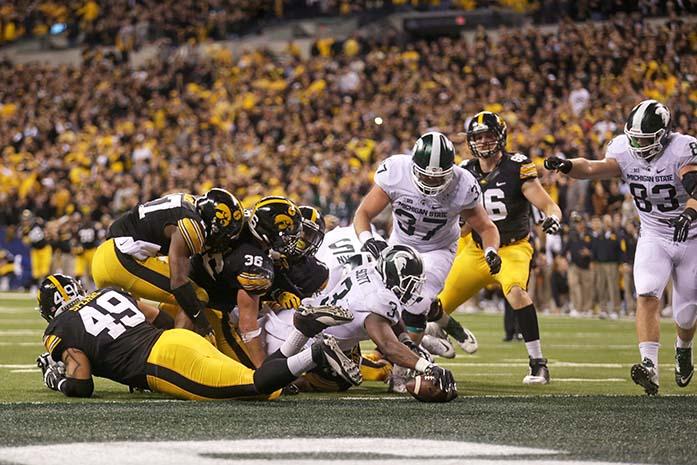Michigan State’s fatal final drive came after slowly and patiently exhausting Iowa’s defense in the third quarter.
By Charlie Green
INDIANAPOLIS — In the context of Iowa’s first loss of 2015, it has become known as “the drive.” Michigan State scored its first touchdown of the Big Ten Championship after a string of 22 plays — complete with four third-down conversions and one on fourth-down at the Hawks’ 5-yard line.
It ended with 27 seconds left until the final whistle and started with 9:31 to go in the fourth quarter.
But that’s not where it really started. It started as soon as the Spartans took the kickoff to begin the second half.
“I know [Spartan quarterback] Connor Cook got shaken up a little bit, so they had to turn to their running game a little bit,” safety Jordan Lomax said. “And their running backs and offensive line did a good job of moving the ball.”
With Cook clearly not at 100 percent, the team turned to more to the run, using both the wildcat formation and old-fashioned power running. Its opening drive of the half lasted nine plays and ended in a punt that set Iowa up at its own 12.
The result of that drive was perfectly fine with head coach Mark Dantonio, because it set the Hawkeyes up with a long field against a front seven playing out of their collective minds.
Iowa went three-and-out, and the Spartans started another drive at their own 42.
Most importantly, Iowa’s defense came back onto the field. And it stayed there.
The Spartans’ next drive took 11 plays and more than four minutes, resulting in a field goal that tied the game at 6. In essence, they used two offensive drives and one defensive stand to inch close enough to get just a few points.
But, in the process, Iowa’s defense was on the field while Michigan State’s was on the sideline.
After another Hawkeye three-and-out, the Spartans again answered with a field goal, continuing to tack up a mounting advantage in time of possession. Not only did they end the quarter with a 9-6 advantage, they controlled the clock for almost two-thirds of the period.
Over the course of those 15 minutes of play, they planted the seeds of the fatal drive that buried the Hawks. Iowa’s defense didn’t break, but it bent just enough — until it finally was pushed to a point where breaking was inevitable.
It meant that Iowa not only needed points but also somewhat sustainable drives in the fourth quarter to flip Sparty’s game plan back in its face. It got the points needed on the first play of the quarter via an 85-yard catch-and-run from Tevaun Smith — a play that took all of 11 seconds.
After the teams traded sub-three-minute drives, the Spartans finished off a truly masterful approach. Iowa’s defense could no longer get off the field, even when it had plenty of opportunities to do so.
By game’s end, Michigan State had controlled the ball for 36:38 compared with just 23:22 for the Hawks.
That statistic, more than any other, points to exactly how the Spartans fought their way into the College Football Playoff.
“We fought hard on defense; they definitely had to earn that long drive that they had, they didn’t get any points easy,” Lomax said. “It was just a great battle, and it was a competitive battle between two great teams.”
Follow @charlsgreen on Twitter for Iowa football news, updates, and analysis.




